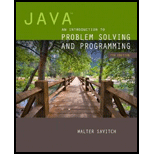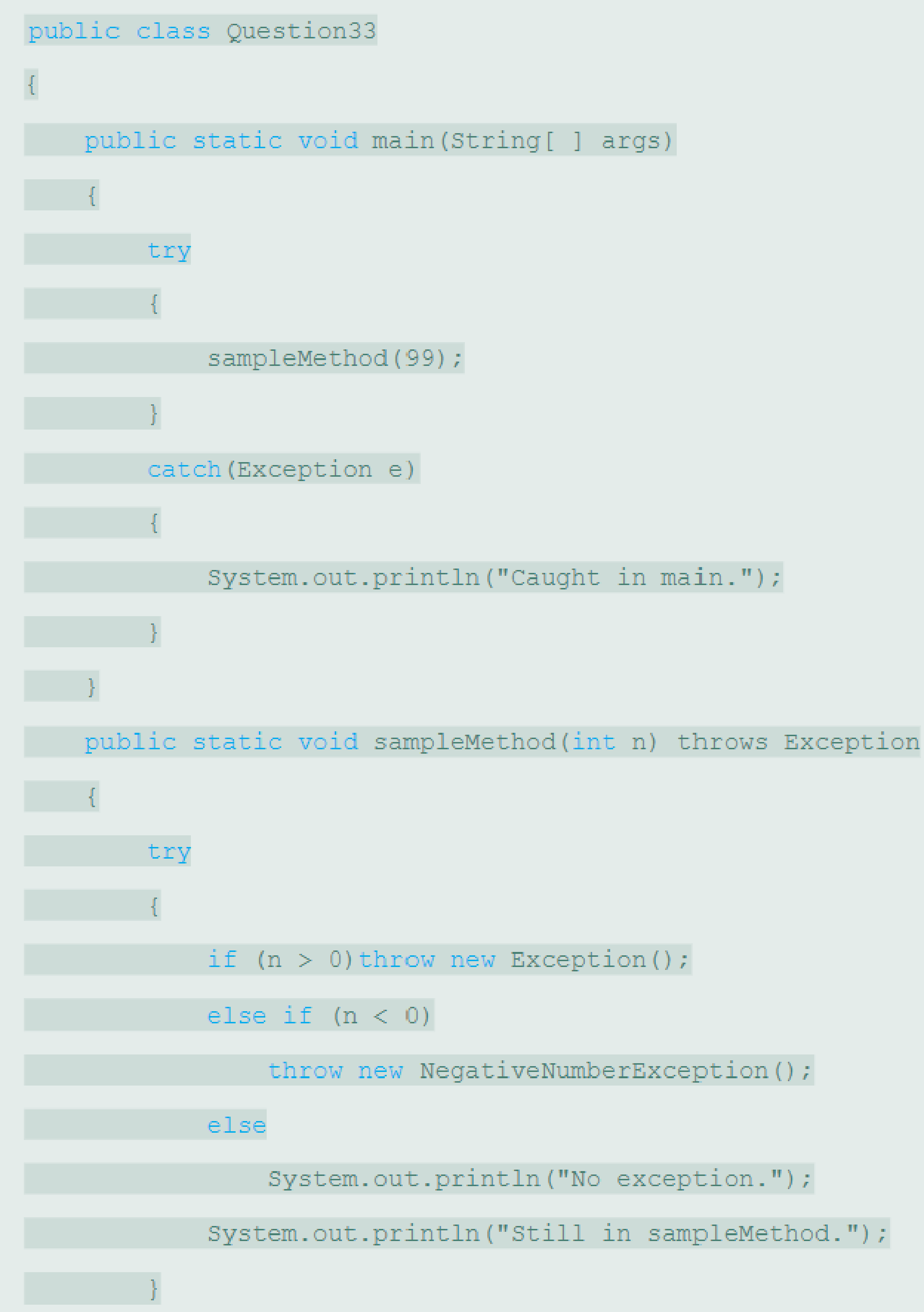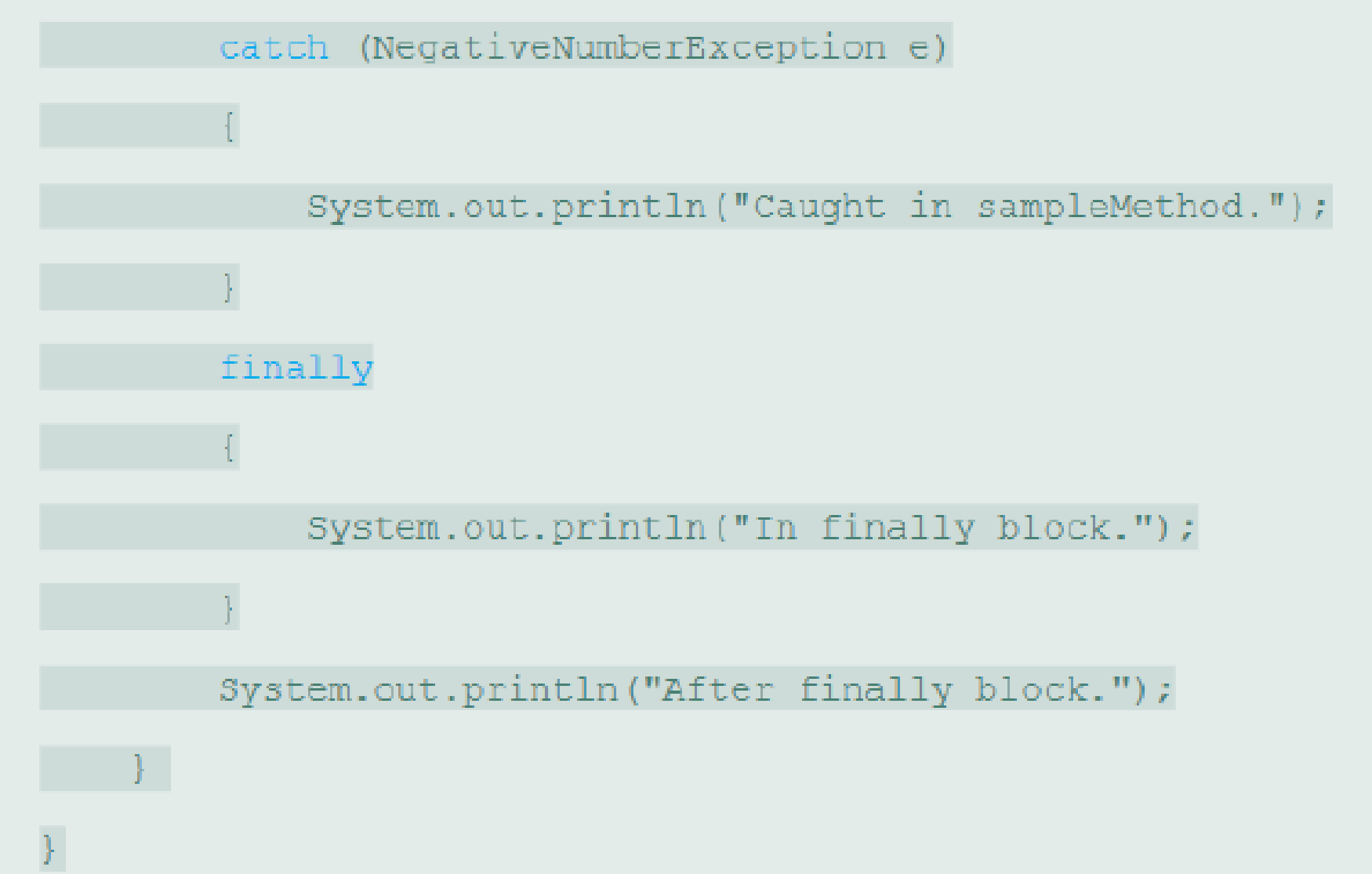
Java: An Introduction to Problem Solving and Programming plus MyProgrammingLab with Pearson eText -- Access Card Package (7th Edition)
7th Edition
ISBN: 9780133862119
Author: Walter Savitch
Publisher: PEARSON
expand_more
expand_more
format_list_bulleted
Concept explainers
Textbook Question
Chapter 9.3, Problem 33STQ
Consider the following


- a. What output does the program produce?
- b. What output would the program produce if the argument to sampleMethod were −99 instead of 99?
- c. What output would the program produce if the argument to sampleMethod were 0 instead of 99?
Expert Solution & Answer
Want to see the full answer?
Check out a sample textbook solution
Students have asked these similar questions
Write a program that simulates a Magic 8 Ball, which is a fortune-telling toy that displays a random response to a yes or no question. In the student sample programs for this book, you will find a text file named 8_ball_responses.txt. The file contains 12 responses, such as “I don’t think so”, “Yes, of course!”, “I’m not sure”, and so forth. The program should read the responses from the file into a list. It should prompt the user to ask a question, then display one of the responses, randomly selected from the list. The program should repeat until the user is ready to quit.
Contents of 8_ball_responses.txt:
Yes, of course! Without a doubt, yes. You can count on it. For sure! Ask me later. I'm not sure. I can't tell you right now. I'll tell you after my nap. No way! I don't think so. Without a doubt, no. The answer is clearly NO.
(You can access the Computer Science Portal at www.pearsonhighered.com/gaddis.)
Start with the initial angles within the integration and just integrate them without mapping them to specific quadrants. Use python and radians
How does encryption prevent a hacker from getting your data
Chapter 9 Solutions
Java: An Introduction to Problem Solving and Programming plus MyProgrammingLab with Pearson eText -- Access Card Package (7th Edition)
Ch. 9.1 - Prob. 1STQCh. 9.1 - What output would the code in the previous...Ch. 9.1 - Prob. 3STQCh. 9.1 - Prob. 4STQCh. 9.1 - Prob. 5STQCh. 9.1 - Prob. 6STQCh. 9.1 - Prob. 7STQCh. 9.1 - Prob. 8STQCh. 9.1 - In the code given in Self-Test Question 1,...Ch. 9.1 - In the code given in Self-Test Question 1,...
Ch. 9.1 - Prob. 11STQCh. 9.1 - Prob. 12STQCh. 9.1 - Prob. 13STQCh. 9.1 - Prob. 14STQCh. 9.2 - Prob. 15STQCh. 9.2 - Prob. 16STQCh. 9.2 - Prob. 17STQCh. 9.2 - Prob. 18STQCh. 9.2 - Prob. 19STQCh. 9.2 - Prob. 20STQCh. 9.2 - Suppose that, in Self-Test Question 19, we change...Ch. 9.2 - Prob. 22STQCh. 9.2 - Prob. 23STQCh. 9.3 - Prob. 24STQCh. 9.3 - Prob. 25STQCh. 9.3 - Prob. 26STQCh. 9.3 - Prob. 27STQCh. 9.3 - Prob. 28STQCh. 9.3 - Repeat Self-Test Question 27, but change the value...Ch. 9.3 - Prob. 30STQCh. 9.3 - Prob. 31STQCh. 9.3 - Prob. 32STQCh. 9.3 - Consider the following program: a. What output...Ch. 9.3 - Write an accessor method called getPrecision that...Ch. 9.3 - Prob. 35STQCh. 9.4 - Rewrite the class ColorDemo in Listing 9.13 so...Ch. 9.4 - Prob. 37STQCh. 9 - Write a program that allows students to schedule...Ch. 9 - Prob. 2ECh. 9 - Prob. 3ECh. 9 - Prob. 4ECh. 9 - Prob. 5ECh. 9 - Write code that reads a string from the keyboard...Ch. 9 - Create a class Rational that represents a rational...Ch. 9 - Prob. 9ECh. 9 - Suppose that you are going to create an object...Ch. 9 - Revise the class RoomCounter described in the...Ch. 9 - Prob. 12ECh. 9 - Write a class LapTimer that can be used to time...Ch. 9 - Prob. 1PCh. 9 - Prob. 2PCh. 9 - Prob. 3PCh. 9 - Write a program that uses the class calculator in...Ch. 9 - Prob. 3PPCh. 9 - Prob. 7PPCh. 9 - Prob. 9PPCh. 9 - Suppose that you are in change of customer service...Ch. 9 - Write an application that implements a trip-time...
Additional Engineering Textbook Solutions
Find more solutions based on key concepts
int[] collection = new int[-20];
Starting Out with Java: From Control Structures through Objects (7th Edition) (What's New in Computer Science)
Porter’s competitive forces model: The model is used to provide a general view about the firms, the competitors...
Management Information Systems: Managing The Digital Firm (16th Edition)
State whether each of the following is true or false. If false, explain why. All expression containing the | | ...
Java How to Program, Early Objects (11th Edition) (Deitel: How to Program)
What is the general problem with static scoping?
Concepts Of Programming Languages
Code an SQL statement that creates a table with all columns from the parent and child tables in your answer to ...
Database Concepts (8th Edition)
For the circuit shown, use the node-voltage method to find v1, v2, and i1.
How much power is delivered to the c...
Electric Circuits. (11th Edition)
Knowledge Booster
Learn more about
Need a deep-dive on the concept behind this application? Look no further. Learn more about this topic, computer-science and related others by exploring similar questions and additional content below.Similar questions
- what type of internet connection should be avoided on mobile devices?arrow_forwardI need help creating the network diagram and then revising it for the modified activity times.arrow_forwardActivity No. Activity Time (weeks) Immediate Predecessors 1 Requirements collection 3 2 Requirements structuring 4 1 3 Process analysis 3 2 4 Data analysis 3 2 5 Logical design 50 3,4 6 Physical design 5 5 7 Implementation 6 6 c. Using the information from part b, prepare a network diagram. Identify the critical path.arrow_forward
- Given the following Extended-BNF grammar of the basic mathematical expressions: Show the derivation steps for the expression: ( 2 + 3 ) * 6 – 20 / ( 3 + 1 ) Draw the parsing tree of this expression. SEE IMAGEarrow_forwardWhentheuserenters!!,themostrecentcommandinthehistoryisexecuted.In the example above, if the user entered the command: Osh> !! The ‘ls -l’ command should be executed and echoed on user’s screen. The command should also be placed in the history buffer as the next command. Whentheuserentersasingle!followedbyanintegerN,theNthcommandin the history is executed. In the example above, if the user entered the command: Osh> ! 3 The ‘ps’ command should be executed and echoed on the user’s screen. The command should also be placed in the history buffer as the next command. Error handling: The program should also manage basic error handling. For example, if there are no commands in the history, entering !! should result in a message “No commands in history.” Also, if there is no command corresponding to the number entered with the single !, the program should output "No such command in history."arrow_forwardActivity No. Activity Time (weeks) Immediate Predecessors 1 Requirements collection 3 2 Requirements structuring 4 1 3 Process analysis 3 2 4 Data analysis 3 2 5 Logical design 50 3,4 6 Physical design 5 5 7 Implementation 6 6 c. Using the information from part b, prepare a network diagram. Identify the critical path.arrow_forward
- 2. UNIX Shell and History Feature [20 points] This question consists of designing a C program to serve as a shell interface that accepts user commands and then executes each command in a separate process. A shell interface gives the user a prompt, after which the next command is entered. The example below illustrates the prompt osh> and the user's next command: cat prog.c. The UNIX/Linux cat command displays the contents of the file prog.c on the terminal using the UNIX/Linux cat command and your program needs to do the same. osh> cat prog.c The above can be achieved by running your shell interface as a parent process. Every time a command is entered, you create a child process by using fork(), which then executes the user's command using one of the system calls in the exec() family (as described in Chapter 3). A C program that provides the general operations of a command-line shell can be seen below. #include #include #define MAX LINE 80 /* The maximum length command */ { int…arrow_forwardQuestion#2: Design and implement a Java program using Abstract Factory and Singleton design patterns. The program displays date and time in one of the following two formats: Format 1: Date: MM/DD/YYYY Time: HH:MM:SS Format 2: Date: DD-MM-YYYY Time: SS,MM,HH The following is how the program works. In the beginning, the program asks the user what display format that she wants. Then the program continuously asks the user to give one of the following commands, and performs the corresponding task. Note that the program gets the current date and time from the system clock (use the appropriate Java date and time operations for this). 'd' display current date 't': display current time 'q': quit the program. • In the program, there should be 2 product hierarchies: "DateObject” and “TimeObject”. Each hierarchy should have format and format2 described above. • Implement the factories as singletons. • Run your code and attach screenshots of the results. • Draw a UML class diagram for the program.arrow_forward#include <linux/module.h> #include <linux/kernel.h> // part 2 #include <linux/sched.h> // part 2 extra #include <linux/hash.h> #include <linux/gcd.h> #include <asm/param.h> #include <linux/jiffies.h> void print_init_PCB(void) { printk(KERN_INFO "init_task pid:%d\n", init_task.pid); printk(KERN_INFO "init_task state:%lu\n", init_task.state); printk(KERN_INFO "init_task flags:%d\n", init_task.flags); printk(KERN_INFO "init_task runtime priority:%d\n", init_task.rt_priority); printk(KERN_INFO "init_task process policy:%d\n", init_task.policy); printk(KERN_INFO "init_task task group id:%d\n", init_task.tgid); } /* This function is called when the module is loaded. */ int simple_init(void) { printk(KERN_INFO "Loading Module\n"); print_init_PCB(); printk(KERN_INFO "Golden Ration Prime = %lu\n", GOLDEN_RATIO_PRIME); printk(KERN_INFO "HZ = %d\n", HZ); printk(KERN_INFO "enter jiffies = %lu\n", jiffies); return 0; } /* This function is called when the…arrow_forward
arrow_back_ios
SEE MORE QUESTIONS
arrow_forward_ios
Recommended textbooks for you
 C++ Programming: From Problem Analysis to Program...Computer ScienceISBN:9781337102087Author:D. S. MalikPublisher:Cengage Learning
C++ Programming: From Problem Analysis to Program...Computer ScienceISBN:9781337102087Author:D. S. MalikPublisher:Cengage Learning Microsoft Visual C#Computer ScienceISBN:9781337102100Author:Joyce, Farrell.Publisher:Cengage Learning,
Microsoft Visual C#Computer ScienceISBN:9781337102100Author:Joyce, Farrell.Publisher:Cengage Learning, C++ for Engineers and ScientistsComputer ScienceISBN:9781133187844Author:Bronson, Gary J.Publisher:Course Technology Ptr
C++ for Engineers and ScientistsComputer ScienceISBN:9781133187844Author:Bronson, Gary J.Publisher:Course Technology Ptr EBK JAVA PROGRAMMINGComputer ScienceISBN:9781337671385Author:FARRELLPublisher:CENGAGE LEARNING - CONSIGNMENT
EBK JAVA PROGRAMMINGComputer ScienceISBN:9781337671385Author:FARRELLPublisher:CENGAGE LEARNING - CONSIGNMENT

C++ Programming: From Problem Analysis to Program...
Computer Science
ISBN:9781337102087
Author:D. S. Malik
Publisher:Cengage Learning

Microsoft Visual C#
Computer Science
ISBN:9781337102100
Author:Joyce, Farrell.
Publisher:Cengage Learning,

C++ for Engineers and Scientists
Computer Science
ISBN:9781133187844
Author:Bronson, Gary J.
Publisher:Course Technology Ptr

EBK JAVA PROGRAMMING
Computer Science
ISBN:9781337671385
Author:FARRELL
Publisher:CENGAGE LEARNING - CONSIGNMENT
Introduction to Operators in C; Author: Neso Academy;https://www.youtube.com/watch?v=50Pb27JoUrw;License: Standard YouTube License, CC-BY